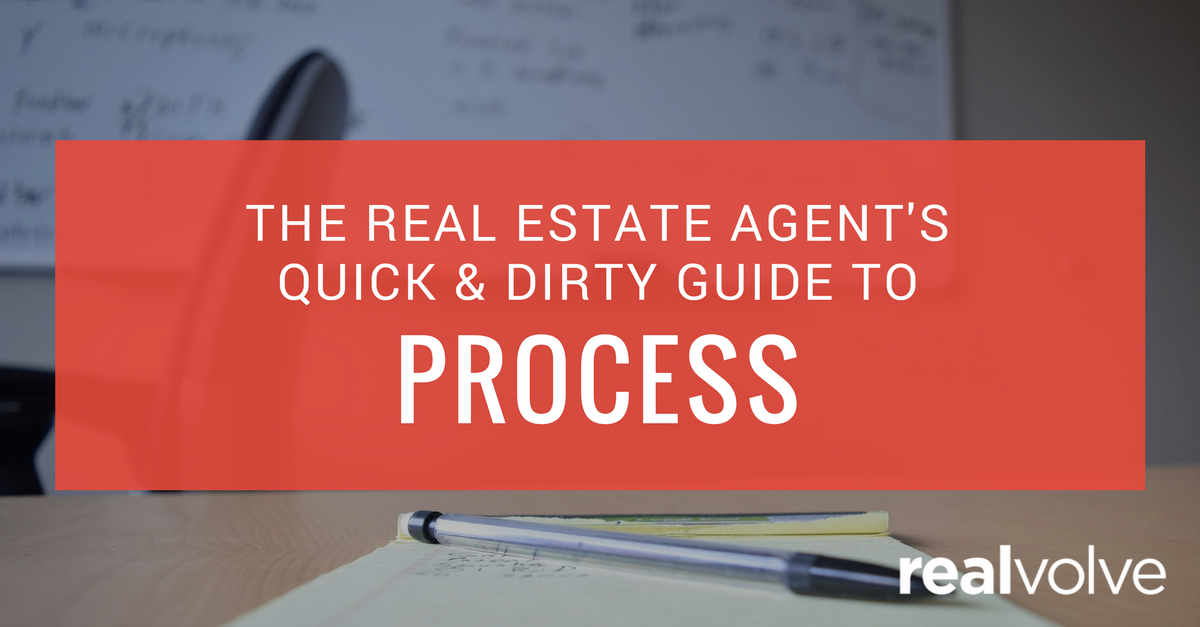I’ve said it many times, and here I am saying it again: Relationships are key to real estate success.
But relationships alone won’t get you there. There are two cornerstones to real estate success, both of equal importance: relationships…and process.
Process is what turns those relationships into transactions. It’s what enables you to convert a prospect to a lead, and a lead to a client. When you have a process to apply to your relationships, your future success becomes more manageable and certain.
We talk about process a lot here on the blog and in our Facebook community. But what do we mean when we say “process?” What does that really look like for a real estate agent? And how do you build it?
All of these questions will be answered—as concisely as possible—in this quick and dirty guide to all things PROCESS.
Jump to a section:
What is a process?
In the simplest terms, a process is a set of activities performed to accomplish a specific goal.
The theory is that by repeating the same tasks over and over again for an extended period of time, you will achieve long term success.
If you have a long term goal to lose weight, for example, your process might look something like this:
- Goal: Lose 25 pounds in 6 months
- Activities:
- Start every day with a glass of water
- Walk 10,000 steps per day
- Eat 5 servings of vegetables each day
- and so on…
In your real estate business, your process is more complex. In fact, your “process” is actually a collection of processes. You have a process for lead generation, a process for managing listings, a process for generating referrals, etc. And within each of those processes, you have a series of steps you take to accomplish your goal.
A high-level look at your referral generation process might look something like this:
- Goal: Generate 10 referral leads per month
- Activities:
- Weekly email campaign to recently-closed clients (within the past month)
- Monthly email campaign to all other past clients
- Quarterly direct mail campaign to past clients
- Wednesday morning phone calls to 5 past clients
- 2 Facebook page posts per week
If we were to go into more detail with this example, the process would also tell us who performs each task and when each task should be done. There would be templates to use—pre-written emails, phone call scripts, text messages, social media posts, etc. And the best processes aren’t just linear To Do lists—they account for all possible scenarios by providing IF/THEN instructions (e.g. IF the client replies to Email A, THEN send them Email B).
Think about all the activities you perform on a daily, weekly, and monthly basis. All of these activities add up to constitute your business process.
Why Process Matters
There are many benefits to having a formalized process for your real estate business:
- Efficiency: You don’t waste any time figuring out the next step, because it’s already spelled out for you.
- Accuracy: You are able to do the right task at the right time.
- Consistency: You ensure the same high quality client experience every time.
- Control: You are able to be proactive (vs. reactive). In other words, you’re not running around putting out fires—you’re on top of things.
- Accountability: When everything is so clearly documented, there’s no confusion about which team member is responsible for a task.
- Improvability: When you don’t have to reinvent your To Do list at the start of each new transaction, it’s easier to make improvements to your process.
- Certainty: Having a process in place makes your income more predictable.
The bottom line: Having a finely tuned process in place—and documenting that process—ensures that you always provide a great client experience while operating as efficiently as possible.
How To Build Your Process
There are two important components to developing your process—planning (defining your goals and the activities you will complete to accomplish those goals) and documenting (putting these activities “in writing,” so you can ensure that you perform them consistently each time).
We believe the best way to document your real estate process is through workflows, so that’s the technique we’ll be discussing below.
10 Tips For Defining & Documenting Your Process
1. Schedule time to work on this.
This is a big undertaking and an important investment in the future of your real estate business. Set aside a couple of days to focus 100% on planning and mapping out your process. Find a place to work where you won’t be interrupted or distracted, then hunker down and grind it out.
2. Choose an awesome mapping tool (one that uses workflows).
You need a tool for documenting and mapping out your process. We suggest Realvolve, which allows you to map your process with workflows. These are like To Do lists on steroids because they’re dynamic instead of linear; they have branches to allow for all the different scenarios you encounter during a real estate transaction. There’s also an automation component to Realvolve, so your workflows can be set up to automatically send emails, add reminders to your calendar, launch a new workflow, etc.
I promise you, workflows will rock your world.
3. Get a solid understanding of the sales funnel.
The sales funnel is basically a person’s journey from suspect to prospect to lead to client…and beyond. Your goal is to move your contacts through each level of the funnel:
Suspect > Prospect > Lead > Client > Past Client
Before you start building out your process, make sure you have a solid understanding of how the sales funnel works. This will help you tremendously. Begin with What Is a Sales Funnel? The Guide to Building an Automated Selling Machine on Entrepreneur.com.
4. Begin with the end in mind.
Define your goals for your real estate business. Put them in writing. And as you develop your process, keep referring back to them. Doing this will ensure that every last detail of your process—whether it’s sending a new client introduction email or setting up lockboxes—brings you one step closer to accomplishing your goals.
5. Create an outline of EVERYTHING you do.
Before you dive into whatever software you’ve chosen for mapping out your process, start on paper first. (And by paper, I mean Microsoft Word or a Google Doc.) You’re early in the planning phase, so you don’t want to cloud your thinking with figuring out how to manipulate the software.
Here’s how I suggest creating your outline:
- Start with your sales funnel to create categories: Suspects to Prospects, Prospects to Leads, Leads to Clients, etc.
- Under each category, list the strategies you use to make that conversion (i.e. to convert prospects to leads, one of your strategies might be Daily emails with bite-sized info).
6. Identify your Whys to define workflows.
Take a step back. Look at your list (it’s probably a long one). Now that you’ve listed everything out, you can start to think about your process in terms of how each step will fit into a workflow.
To decide what workflows you need to create, go through each category and ask yourself Why. As in, why do I need a workflow for this stage of the funnel?
Here are some examples:
- Why do I need workflows for the Suspects to Prospects stage?
- I need to run a Facebook ad campaign.
- I need to manage my prospecting content strategy (blogging, enewsletter, social media, etc.).
- Why do I need workflows for the Leads to Clients stage?
- I need to follow up with my lead to secure an appointment.
- I need to prepare for our first meeting.
- Why do I need workflows for the Clients to Past Clients stage?
- I have a new listing to manage.
- We are 60 days from close.
These Why statements will become the titles of your workflows:
- Facebook Ad Workflow
- Prospect Workflow
- Lead Follow Up Workflow
- Pre-Listing Prep Workflow
- New Listing Workflow
- Closing Seller Workflow
- and so on…
7. Fill in the details of each workflow.
For each workflow you plan to create, provide further details:
-
- WHO is responsible for this activity? (And WHO is on the receiving end…the client? The home inspector? Another agent?)
- HOW is this activity completed? (Provide step-by-step instructions.)
- WHAT are the steps to carry out this workflow? WHAT templates are required? (Make a note of any pre-written emails, texts, phone call scripts you use.)
- WHEN does this need to happen? (E.g. 3 days before closing.)
It can be helpful to fill in all of these details as you’re going through an actual transaction.
8. Don’t start from scratch.
I know. This whole “developing a process” thing can be overwhelming. I’m not gonna lie to you—it’s a huge project…but there are ways to make it easier.
Others have done this before you, and many of them will be kind enough to share the fruits of their labor. If you are a Realvolve user, for instance, you have access to a workflow library where you can download fully built-out workflows and edit them to use for your own business. Some workflows in the library are free; some are paid.
No matter what tool you are using, be sure to leverage whatever pre-existing resources are available.
9. Take the time to learn the software.
It’s a valuable time investment. Take advantage of the support line, online communities, webinars, and documentation. This way, you’ll know exactly what you’re doing when it’s finally time to put your process into the software.
10. Always be improving
Once your process has been mapped out in the software, you’re still not done. Because you’re never done. If you intend to be competitive and build a business that will last a lifetime, you must continue to improve. Seek out better ways to serve your clients. Stay up-to-date with the latest technology. Learn from your peers. And then update your process as you discover new, better ways to run your real estate business.
Conclusion
So there you have it—your quick and dirty guide to all things process.
Now you know why we’re always talking about the importance of process. Having a process eliminates the fear of the unknown. It makes the future more certain, and your income more predictable. You can ensure that you’ll generate enough new leads each quarter. You can enter into each new transaction with the confidence that nothing will fall through the cracks.
If you haven’t formally developed your business process, get started today. Begin reading up on the sales funnel, and take some time to think about your long-term goals. Then feel free to give us a call. We’d love to help you build out a process that will ensure your future success.
Build Your Process With Realvolve
Here at Realvolve, our philosophy is that relationships and process are at the heart of every great business. Those are the fundamentals upon which we built our real estate CRM.
Learn more about how Realvolve helps you automate tasks, solidify your process, and build a sustainable real estate business. Or jump right in and try Realvolve for free (no credit card required).





